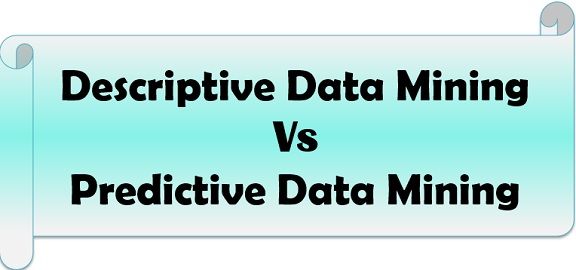 The descriptive and predictive data mining techniques are used in data mining to mine the types of patterns. The descriptive analysis is used to mine data and provide the latest information on past or recent events. On the other hand, the predictive analysis provides answers of the future queries that move across using historical data as the chief principle for decisions.
The descriptive and predictive data mining techniques are used in data mining to mine the types of patterns. The descriptive analysis is used to mine data and provide the latest information on past or recent events. On the other hand, the predictive analysis provides answers of the future queries that move across using historical data as the chief principle for decisions.
Data mining tasks can be descriptive, predictive and prescriptive. Here we are just discussing the two of them descriptive and prescriptive. In simple words, descriptive implicates discovering the interesting patterns or association relating the data whereas predictive involves the prediction and classification of the behaviour of the model founded on the current and past data.
Content: Descriptive Data Mining Vs Predictive Data Mining
Comparison Chart
| Basis for comparison | Descriptive Mining | Predictive Mining |
|---|---|---|
| Basic | It identifies, what happened in the past by analyzing stored data | It describes, what can happen in the future with the help past data analysis. |
| Require | Data aggregation and data mining | Statistics and forecasting methods |
| Preciseness | Provides accurate data | Produces results does not ensure accuracy. |
| Type of approach | Reactive | Proactive |
| Practical analysis methods | Standard reporting, query/drill down and ad-hoc reporting. | Predictive modelling, forecasting, simulation and alerts. |
Definition of Descriptive Data Mining
Descriptive mining is generally used to produce correlation, cross tabulation, frequency etcetera. These techniques are determined to find the regularities in the data and to reveal patterns. The other application of descriptive analysis is to discover the captivating subgroups in the major part of the data.
Descriptive analytics focuses on the summarization and conversion of the data into meaningful information for reporting and monitoring. Furthermore, it permits to examine the data in a detailed way so that it would be able to answer easily about “what has happened?” and “what is happening?”. Clustering, summarization, association are the techniques categorized under descriptive mining.
Definition of Predictive Data Mining
The primary objective of predictive mining is to predict future results instead of current behaviour. It involves the supervised learning functions used for the prediction of the target value. The methods fall under this mining category are the classification, time-series analysis and regression. Data modelling is the necessity of the predictive analysis, which works by utilizing some variables to anticipate the unknown future data values for other variables.
Additionally, it also conducts the comparison among these supervised learning methods for obtaining the prescience about the strength and weaknesses of each approach. This whole process is performed to find out the most suitable method for extracting the desired knowledge. The predictive analysis is used for providing information about “what might happen?” and “why it might happen?”.
Key Differences Between Descriptive and Predictive Data Mining
- Descriptive mining tasks describe the characteristics of the data in a target data set. On the other hand, predictive mining tasks carry out the induction over the current and past data so that predictions can be made.
- In terms of accuracy, the descriptive technique is more precise and accurate as compared to predictive mining.
- The predictive analysis involves control over the situation along with responding to it while descriptive analysis just responds to the situation.
- The operation performed in the descriptive approach are standard reporting, query/drill down and ad-hoc reporting which are capable of generating the response of –
- what happened?
- where exactly is the problem?
- what is the frequency of the problem?
As against, predictive mining performs tasks like predictive modelling, forecasting, simulation and alerts. These involve the result of questions like –
- what will happen next?
- what is the outcome if these trends continue?
- what actions are required to be taken?
Conclusion
Descriptive mining employs unsupervised learning functions while predictive uses supervised learning techniques. This is the reason the descriptive analysis is not able to anticipate the unknown target values but concentrates more on the intrinsic arrangement, interconnections and relations. Conversely, predictive mining specifies and distinguishes a set of data for future prediction.
Lovely Sharma says
Impressively written! This piece of writing cleared all doubts. I really appreciate the way you described the difference. Hope to see more write-ups like this!
Rahul Asrani says
It’s always good to see ur differences in arranging chart manners ,it clears and summarize every details effectively!!